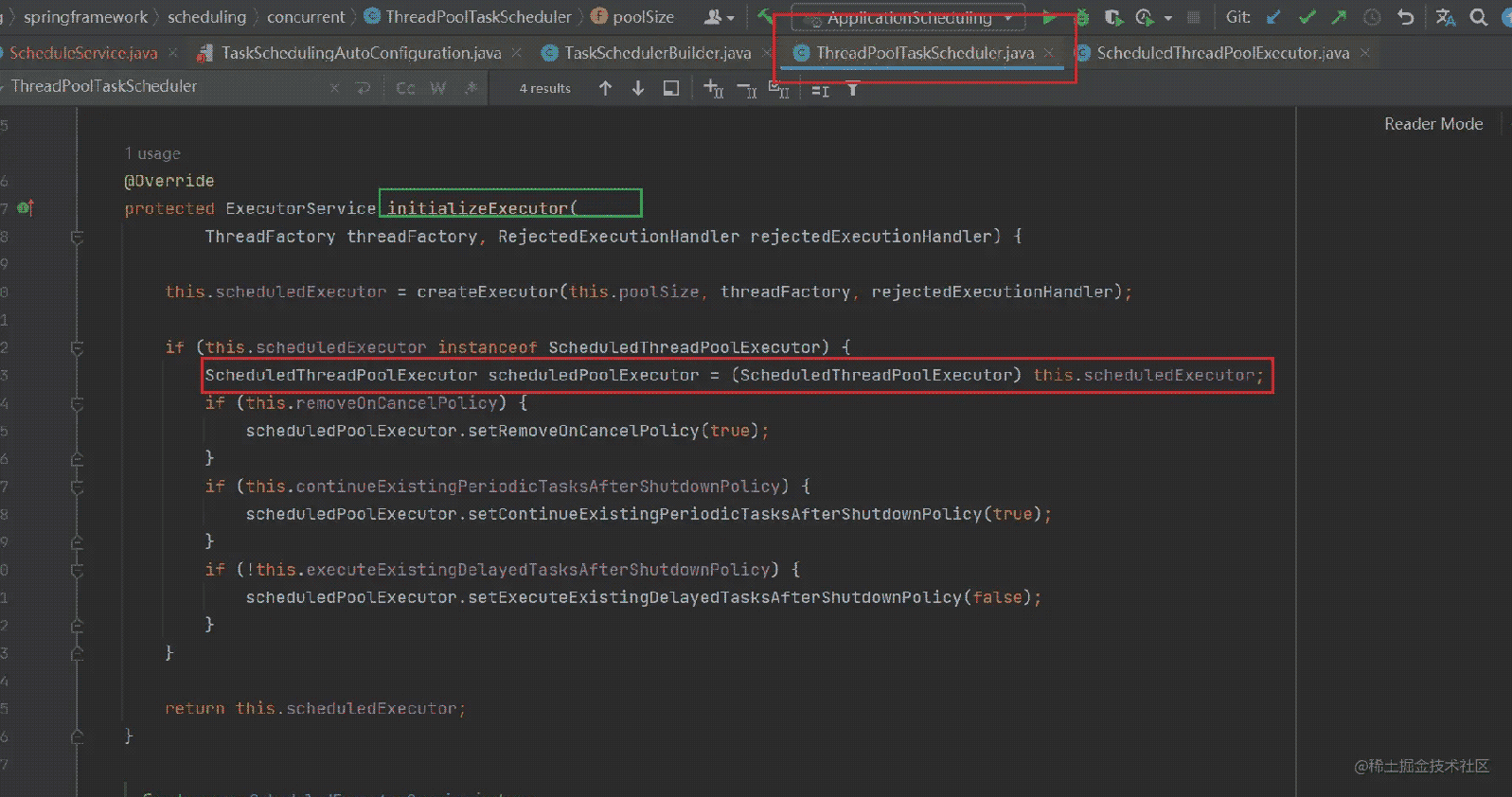目录
- 正文
- 一、搭建基本环境
- 二、问题::执行时间延迟和单线程执行
- 三、为什么会出现上述问题?
- 四、解决方式
- 4.1、修改配置文件
- 4.2、执行逻辑改为异步执行
- 4.3、异步定时任务
- 4.4、小结
- 五、分布式下的思考
- 思考:并发执行
- 解决方式:分布式锁
- 后记
正文
定时任务的实现方式多种多样,框架也是层出不穷。
本文所谈及的是 SpringBoot 本身所带有的@EnableScheduling 、 @Scheduled实现定时任务的方式。
以及采用这种方式,在分布式调度中可能会出现的问题,又针对为什么会发生这种问题?又该如何解决,做出了一些叙述。
为了适合每个阶段的读者,我把前面测试的代码都贴出来啦~
确保每一步都是有迹可循的,希望大家不要嫌啰嗦,感谢
一、搭建基本环境
基本依赖
<parent>
<artifactId>spring-boot-parent</artifactId>
<groupId>org.springframework.boot</groupId>
<version>2.7.2</version>
</parent>
<dependencies>
<dependency>
<groupId>org.springframework.boot</groupId>
<artifactId>spring-boot</artifactId>
</dependency>
<dependency>
<groupId>org.springframework.boot</groupId>
<artifactId>spring-boot-starter</artifactId>
</dependency>
<dependency>
<groupId>org.springframework.boot</groupId>
<artifactId>spring-boot-starter-web</artifactId>
</dependency>
<dependency>
<dependency>
<groupId>org.projectlombok</groupId>
<artifactId>lombok</artifactId>
</dependency>
</dependencies>
创建个启动类及定时任务
@SpringBootApplication
public class ApplicationScheduling {
public static void main(String[] args) {
SpringApplication.run(ApplicationScheduling.class, args);
}
}
/**
* @description:
* @author: Ning Zaichun
* @date: 2022年09月06日 0:02
*/
@Slf4j
@Component
@EnableScheduling
public class ScheduleService {
// 每五秒执行一次,cron的表达式就不再多说明了
@Scheduled(cron = "0/5 * * * * ? ")
public void testSchedule() {
log.info("当前执行任务的线程号ID===>{}", Thread.currentThread().getId());
}
}
二、问题::执行时间延迟和单线程执行
按照上面代码中给定的cron表达式@Scheduled(cron = "0/5 * * * * ? ")每五秒执行一次,那么最近五次的执行结果应当为:
2022-09-06 00:21:10
2022-09-06 00:21:15
2022-09-06 00:21:20
2022-09-06 00:21:25
2022-09-06 00:21:30
如果定时任务中是执行非常快的任务的,时间非常非常短,确实不会有什么的延迟性。
上面代码执行结果:
2022-09-06 19:42:10.018 INFO 24496 --- [ scheduling-1] com.nzc.service.ScheduleService : 当前执行任务的线程号ID===>64
2022-09-06 19:42:15.015 INFO 24496 --- [ scheduling-1] com.nzc.service.ScheduleService : 当前执行任务的线程号ID===>64
2022-09-06 19:42:20.001 INFO 24496 --- [ scheduling-1] com.nzc.service.ScheduleService : 当前执行任务的线程号ID===>64
2022-09-06 19:42:25.005 INFO 24496 --- [ scheduling-1] com.nzc.service.ScheduleService : 当前执行任务的线程号ID===>64
2022-09-06 19:42:30.007 INFO 24496 --- [ scheduling-1] com.nzc.service.ScheduleService : 当前执行任务的线程号ID===>64
如果说从时间上来看,说不上什么延迟性,但真实的业务场景中,业务的执行时间可能远比这里时间长。
我主动让线程睡上10秒,让我们再来看看输出结果是如何的吧
@Scheduled(cron = "0/5 * * * * ? ")
public void testSchedule() {
try {
Thread.sleep(10000);
log.info("当前执行任务的线程号ID===>{}", Thread.currentThread().getId());
} catch (Exception e) {
e.printStackTrace();
}
}
输出结果
2022-09-06 19:46:50.019 INFO 27236 --- [ scheduling-1] com.nzc.service.ScheduleService : 当前执行任务的线程号ID===>64
2022-09-06 19:47:05.024 INFO 27236 --- [ scheduling-1] com.nzc.service.ScheduleService : 当前执行任务的线程号ID===>64
2022-09-06 19:47:20.016 INFO 27236 --- [ scheduling-1] com.nzc.service.ScheduleService : 当前执行任务的线程号ID===>64
2022-09-06 19:47:35.005 INFO 27236 --- [ scheduling-1] com.nzc.service.ScheduleService : 当前执行任务的线程号ID===>64
2022-09-06 19:47:50.006 INFO 27236 --- [ scheduling-1] com.nzc.service.ScheduleService : 当前执行任务的线程号ID===>64
请注意两个问题:
- 执行时间延迟:从时间上可以明显看出,不再是每五秒执行一次,执行时间延迟很多,造成任务的
- 单线程执行:从始至终都只有一个线程在执行任务,造成任务的堵塞.
三、为什么会出现上述问题?
问题的根本:线程阻塞式执行,执行任务线程数量过少。
那到底是为什么呢?
回到启动类上,我们在启动上标明了一个@EnableScheduling注解。
大家在看到诸如@Enablexxxx这样的注解的时候,就要知道它一定有一个xxxxxAutoConfiguration的自动装配的类。
@EnableScheduling也不例外,它的自动装配的类是TaskSchedulingAutoConfiguration。
我们来看看它到底做了一些什么设置?我们如何修改?
@ConditionalOnClass(ThreadPoolTaskScheduler.class)
@Configuration(proxyBeanMethods = false)
@EnableConfigurationProperties(TaskSchedulingProperties.class)
@AutoConfigureAfter(TaskExecutionAutoConfiguration.class)
public class TaskSchedulingAutoConfiguration {
@Bean
@ConditionalOnBean(name = TaskManagementConfigUtils.SCHEDULED_ANNOTATION_PROCESSOR_BEAN_NAME)
@ConditionalOnMissingBean({ SchedulingConfigurer.class, TaskScheduler.class, ScheduledExecutorService.class })
public ThreadPoolTaskScheduler taskScheduler(TaskSchedulerBuilder builder) {
return builder.build();
}
// ......
}
可以看到它也是构造了一个 线程池注入到Spring 中
从build()调用继续看下去,
public ThreadPoolTaskScheduler build() {
return configure(new ThreadPoolTaskScheduler());
}
ThreadPoolTaskScheduler中,给定的线程池的核心参数就为1,这也表明了之前为什么只有一条线程在执行任务。private volatile int poolSize = 1;
这一段是分开的用代码不好展示,我用图片标明出来。

主要逻辑在这里,创建线程池的时候,只使用了三个参数,剩下的都是使用ScheduledExecutorService的默认的参数
protected ScheduledExecutorService createExecutor(
int poolSize, ThreadFactory threadFactory, RejectedExecutionHandler rejectedExecutionHandler)
而这默认参数是不行的,生产环境的大坑,阿里的 Java 开发手册中也明确规定,要手动创建线程池,并给定合适的参数值~是为什么呢?
因为默认的线程池中, 池中允许的最大线程数和最大任务等待队列都是Integer.MAX_VALUE.

大家都懂的,如果使用这玩意,只要出了问题,必定挂~
configure(new ThreadPoolTaskScheduler())这里就是构造,略过~
如果已经较为熟悉SpringBoot的朋友,现在已然明白解决当前问题的方式~
四、解决方式
1、@EnableConfigurationProperties(TaskSchedulingProperties.class) ,自动装配类通常也都会对应有个xxxxProperties文件滴,TaskSchedulingProperties也确实可以配置核心线程数等基本参数,但是无法配置线程池中最大的线程数量和等待队列数量,这种方式还是不合适的。
2、可以手动异步编排,交给某个线程池来执行。
3、将定时任务加上异步注解@Async,将其改为异步的定时任务,另外自定义一个系统通用的线程池,让异步任务使用该线程执行任务~
我们分别针对上述三种方式来实现一遍
4.1、修改配置文件
可以配置的就下面几项~
spring:
task:
scheduling:
thread-name-prefix: nzc-schedule- #线程名前缀
pool:
size: 10 #核心线程数
# shutdown:
# await-termination: true #执行程序是否应等待计划任务在关机时完成。
# await-termination-period: #执行程序应等待剩余任务完成的最长时间。
测试结果:
2022-09-06 20:49:15.015 INFO 7852 --- [ nzc-schedule-1] com.nzc.service.ScheduleService : 当前执行任务的线程号ID===>64
2022-09-06 20:49:30.004 INFO 7852 --- [ nzc-schedule-2] com.nzc.service.ScheduleService : 当前执行任务的线程号ID===>66
2022-09-06 20:49:45.024 INFO 7852 --- [ nzc-schedule-1] com.nzc.service.ScheduleService : 当前执行任务的线程号ID===>64
2022-09-06 20:50:00.025 INFO 7852 --- [ nzc-schedule-3] com.nzc.service.ScheduleService : 当前执行任务的线程号ID===>67
2022-09-06 20:50:15.023 INFO 7852 --- [ nzc-schedule-2] com.nzc.service.ScheduleService : 当前执行任务的线程号ID===>66
2022-09-06 20:50:30.008 INFO 7852 --- [ nzc-schedule-4] com.nzc.service.ScheduleService : 当前执行任务的线程号ID===>68
请注意:这里的配置并非是一定生效的,修改后有可能成功,有可能失败,具体原因未知,但这一点是真实存在的。
不过从执行结果中可以看出,这里的执行的线程不再是孤单单的一个。
4.2、执行逻辑改为异步执行
首先我们先向Spring中注入一个我们自己编写的线程池,参数自己设置即可,我这里比较随意。
@Configuration
public class MyTheadPoolConfig {
@Bean
public TaskExecutor taskExecutor() {
ThreadPoolTaskExecutor executor = new ThreadPoolTaskExecutor();
//设置核心线程数
executor.setCorePoolSize(10);
//设置最大线程数
executor.setMaxPoolSize(20);
//缓冲队列200:用来缓冲执行任务的队列
executor.setQueueCapacity(200);
//线程活路时间 60 秒
executor.setKeepAliveSeconds(60);
//线程池名的前缀:设置好了之后可以方便我们定位处理任务所在的线程池
// 这里我继续沿用 scheduling 默认的线程名前缀
executor.setThreadNamePrefix("nzc-create-scheduling-");
//设置拒绝策略
executor.setRejectedExecutionHandler(new ThreadPoolExecutor.CallerRunsPolicy());
executor.setWaitForTasksToCompleteOnShutdown(true);
return executor;
}
}
然后在定时任务这里注入进去:
/**
* @description:
* @author: Ning Zaichun
* @date: 2022年09月06日 0:02
*/
@Slf4j
@Component
@EnableScheduling
public class ScheduleService {
@Autowired
TaskExecutor taskExecutor;
@Scheduled(cron = "0/5 * * * * ? ")
public void testSchedule() {
CompletableFuture.runAsync(()->{
try {
Thread.sleep(10000);
log.info("当前执行任务的线程号ID===>{}", Thread.currentThread().getId());
} catch (Exception e) {
e.printStackTrace();
}
},taskExecutor);
}
}
测试结果:
2022-09-06 21:00:00.019 INFO 18356 --- [te-scheduling-1] com.nzc.service.ScheduleService : 当前执行任务的线程号ID===>66
2022-09-06 21:00:05.022 INFO 18356 --- [te-scheduling-2] com.nzc.service.ScheduleService : 当前执行任务的线程号ID===>67
2022-09-06 21:00:10.013 INFO 18356 --- [te-scheduling-3] com.nzc.service.ScheduleService : 当前执行任务的线程号ID===>68
2022-09-06 21:00:15.020 INFO 18356 --- [te-scheduling-4] com.nzc.service.ScheduleService : 当前执行任务的线程号ID===>69
2022-09-06 21:00:20.026 INFO 18356 --- [te-scheduling-5] com.nzc.service.ScheduleService : 当前执行任务的线程号ID===>70
可以看到虽然业务执行时间比较长,但是木有再出现,延迟执行定时任务的情况。
4.3、异步定时任务
异步定时任务其实和上面的方式原理是一样的,不过实现稍稍不同罢了。
在定时任务的类上再加一个@EnableAsync注解,给方法添加一个@Async即可。
不过一般@Async都会指定线程池,比如写成这样@Async(value = "taskExecutor"),
/**
* @description:
* @author: Ning Zaichun
* @date: 2022年09月06日 0:02
*/
@Slf4j
@Component
@EnableAsync
@EnableScheduling
public class ScheduleService {
@Autowired
TaskExecutor taskExecutor;
@Async(value = "taskExecutor")
@Scheduled(cron = "0/5 * * * * ? ")
public void testSchedule() {
try {
Thread.sleep(10000);
log.info("当前执行任务的线程号ID===>{}", Thread.currentThread().getId());
} catch (Exception e) {
e.printStackTrace();
}
}
}
执行结果:
2022-09-06 21:10:15.022 INFO 22760 --- [zc-scheduling-1] com.nzc.service.ScheduleService : 当前执行任务的线程号ID===>66
2022-09-06 21:10:20.021 INFO 22760 --- [zc-scheduling-2] com.nzc.service.ScheduleService : 当前执行任务的线程号ID===>67
2022-09-06 21:10:25.007 INFO 22760 --- [zc-scheduling-3] com.nzc.service.ScheduleService : 当前执行任务的线程号ID===>68
2022-09-06 21:10:30.020 INFO 22760 --- [zc-scheduling-4] com.nzc.service.ScheduleService : 当前执行任务的线程号ID===>69
2022-09-06 21:10:35.007 INFO 22760 --- [zc-scheduling-5] com.nzc.service.ScheduleService : 当前执行任务的线程号ID===>70
结果显而易见是可行的啦~
分析:
@EnableAsync注解相应的也有一个自动装配类为TaskExecutionAutoConfiguration
也有一个TaskExecutionProperties配置类,可以在yml文件中对参数进行设置,这里的话是可以配置线程池最大存活数量的。
它的默认核心线程数为8,这里我不再进行演示了,同时它的线程池中最大存活数量以及任务等待数量也都为Integer.MAX_VALUE,这也是不建议大家使用默认线程池的原因。
4.4、小结
/** * 定时任务 * 1、@EnableScheduling 开启定时任务 * 2、@Scheduled开启一个定时任务 * 3、自动装配类 TaskSchedulingAutoConfiguration * * 异步任务 * 1、@EnableAsync:开启异步任务 * 2、@Async:给希望异步执行的方法标注 * 3、自动装配类 TaskExecutionAutoConfiguration */
实现方式虽不同,但从效率而言,并无太大区别,觉得那种合适使用那种便可。
不过总结起来,考查的都是对线程池的理解,对于线程池的了解是真的非常重要的,也很有用处。
五、分布式下的思考
针对上述情况而言,这些解决方法在不引入第三包的情况下是足以应付大部分情况了。
定时框架的实现有许多方式,在此并非打算讨论这个。
在单体项目中,也许上面的问题是解决了,但是站在分布式的情况下考虑,就并非是安全的了。
当多个项目在同时运行,那么必然会有多个项目同时这段代码。
思考:并发执行
如果一个定时任务同时在多个机器中运行,会产生怎么样的问题?
假如这个定时任务是收集某个信息,发送给消息队列,如果多台机器同时执行,同时给消息队列发送信息,那么必然导致之后产生一系列的脏数据。这是非常不可靠的
解决方式:分布式锁
很简单也不简单,加分布式锁~ 或者是用一些分布式调度的框架
如使用XXL-JOB实现,或者是其他的定时任务框架。
大家在执行这个定时任务之前,先去获取一把分布式锁,获取到了就执行,获取不到就直接结束。
我这里使用的是 redission,因为方便,打算写分布式锁的文章,还在准备当中。
redission官方文档,我觉得应当算是比较友好的文档了哈哈
加入依赖:
<dependency>
<groupId>org.springframework.boot</groupId>
<artifactId>spring-boot-starter-data-redis</artifactId>
</dependency>
<dependency>
<groupId>org.redisson</groupId>
<artifactId>redisson-spring-boot-starter</artifactId>
<version>3.17.6</version>
</dependency>
按照文档说的,编写配置类,注入 RedissonClient,redisson的全部操作都是基于此。
/**
* @description:
* @author: Ning Zaichun
* @date: 2022年09月06日 9:31
*/
@Configuration
public class MyRedissonConfig {
/**
* 所有对Redisson的使用都是通过RedissonClient
* @return
* @throws IOException
*/
@Bean(destroyMethod="shutdown")
public RedissonClient redissonClient() throws IOException {
//1、创建配置
Config config = new Config();
// 这里规定要用 redis://+IP地址
config.useSingleServer().setAddress("redis://xxxxx:6379").setPassword("000415"); // 有密码就写密码~ 木有不用写~
//2、根据Config创建出RedissonClient实例
//Redis url should start with redis:// or rediss://
RedissonClient redissonClient = Redisson.create(config);
return redissonClient;
}
}
修改定时任务:
/**
* @description:
* @author: Ning Zaichun
* @date: 2022年09月06日 0:02
*/
@Slf4j
@Component
@EnableAsync
@EnableScheduling
public class ScheduleService {
@Autowired
TaskExecutor taskExecutor;
@Autowired
RedissonClient redissonClient;
private final String SCHEDULE_LOCK = "schedule:lock";
@Async(value = "taskExecutor")
@Scheduled(cron = "0/5 * * * * ? ")
public void testSchedule() {
//分布式锁
RLock lock = redissonClient.getLock(SCHEDULE_LOCK);
try {
//加锁 10 为时间,加上时间 默认会去掉 redisson 的看门狗机制(即自动续锁机制)
lock.lock(10, TimeUnit.SECONDS);
Thread.sleep(10000);
log.info("当前执行任务的线程号ID===>{}", Thread.currentThread().getId());
} catch (Exception e) {
e.printStackTrace();
} finally {
// 一定要记得解锁~
lock.unlock();
}
}
}
这里只是给出个大概的实现,实际上还是可以优化的,比如在给定一个flag,在获取锁之前判断。如果有人抢到锁,就修改这个值,之后的请求,判断这个flag,如果不是默认的值,则直接结束任务等等。
思考:继续往深处思考,在分布式情况下如果一个定时任务抢到锁,但是它在执行业务过程中失败或者是宕机了,这又该如何处理呢?如何补偿呢?
个人思考:
失败还比较好说,我们可以直接try{}catch(){}中进行通知告警,及时检查出问题。
如果是挂了,我还没想好怎么做。
后记
但实际上,我所阐述的这种方式,只能说适用于简单的单体项目,一旦牵扯到动态定时任务,使用这种方式就不再那么方便了。
大部分都是使用定时任务框架集成了,尤其是分布式调度远比单体项目需要考虑多的多。
以上就是Schedule定时任务在分布式产生的问题详解的详细内容,更多关于Schedule定时任务分布式的资料请关注自由互联其它相关文章!
